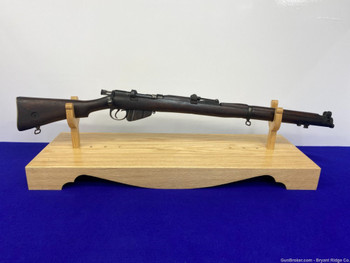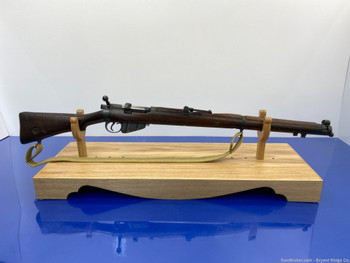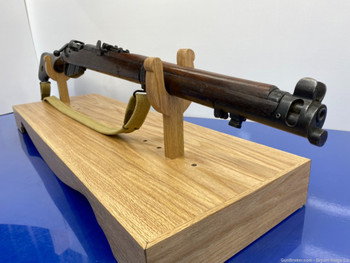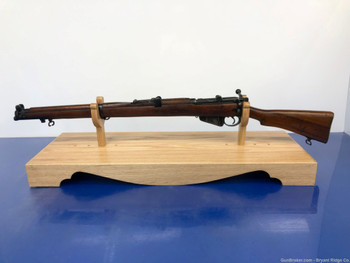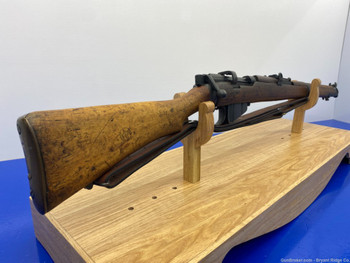Description
Item Description
Bryant Ridge Co. is pleased to present this historic WWI-era bolt-action rifle for a penny-start auction; this is the Birmingham Small Arms Company (B.S.A. Co.) Enfield SHT LE III*!
SPECIFICATIONS:
Manufacturer: Enfield, Produced by Birmingham Small Arms Co. Ltd. (B.S.A.) of England
Model: SHT LE III* (Short Magazine Lee-Enfield Mk III). Later Designated No.1 MkIII.
Serial: K4348
Date of Manufacture: 1917
Caliber: .303 British
Finish: Blue
Barrel Length: 25 ¼"
Optics/Sights: Wing Protected Blade Front and Graduated Tangent Ladder Rear
Stock/Grips: Hardwood
Action: Bolt-Action
Markings: The import mark on the right front of the receiver reads “ENGLAND.” The right front of the receiver, rear of the bolt handle, face of the nosecap, and bottom front of the forearm are each marked with the serial number. The left front of the receiver is marked with a “crowned” proof and a “crowned” inspection stamp. The right side of the stock collar is marked “crown / G R” (George Rex) and “B.S.A. Co / 1917 / SHT LE / III*”. The bolt head is marked “U” and with “crossed flags”. The barrel is marked “HV / SC” (signifies a high velocity rear sight) at the back of the rear sight base. The bottom of the grip, bottom of the butt, and bottom of the forearm are marked with inspection stamps that include “crowns”. There are a few other small British stampings on the rifle.
Bryant Ridge's Analysis:
The Lee–Enfield is a bolt-action, magazine-fed repeating rifle that served as the primary firearm for the military forces of the British Empire and Commonwealth from its official adoption in 1895 until 1957. Evolving from the earlier Lee–Metford rifle, it replaced the Martini–Henry and Martini–Enfield models, featuring a ten-round box magazine that accommodated the .303 British cartridge, which could be loaded individually or using five-round chargers. This rifle became the standard-issue weapon for British Army rifle companies and colonial forces, playing a significant role in both World Wars and remaining in service with various Commonwealth nations, including Australia, New Zealand, South Africa, and Canada. Although it was officially supplanted by the L1A1 SLR in 1957, the Lee–Enfield continued to see use into the 1960s, with its 7.62 mm L42A1 sniper variant lasting until the 1990s. Remarkably, it is still used by some Commonwealth armed forces, such as the Bangladesh Police, making it the second longest-serving military bolt-action rifle still in active service, following the Mosin–Nagant. With an estimated production of over 17 million rifles, the Lee–Enfield reflects both its enduring legacy and the influence of its designer, James Paris Lee, along with its development at the Royal Small Arms Factory in Enfield.
Model: SHT LE III* (Short Magazine Lee-Enfield Mk III). Later Designated No.1 MkIII.
Serial: K4348
Date of Manufacture: 1917
Caliber: .303 British
Finish: Blue
Barrel Length: 25 ¼"
Optics/Sights: Wing Protected Blade Front and Graduated Tangent Ladder Rear
Stock/Grips: Hardwood
Action: Bolt-Action
Markings: The import mark on the right front of the receiver reads “ENGLAND.” The right front of the receiver, rear of the bolt handle, face of the nosecap, and bottom front of the forearm are each marked with the serial number. The left front of the receiver is marked with a “crowned” proof and a “crowned” inspection stamp. The right side of the stock collar is marked “crown / G R” (George Rex) and “B.S.A. Co / 1917 / SHT LE / III*”. The bolt head is marked “U” and with “crossed flags”. The barrel is marked “HV / SC” (signifies a high velocity rear sight) at the back of the rear sight base. The bottom of the grip, bottom of the butt, and bottom of the forearm are marked with inspection stamps that include “crowns”. There are a few other small British stampings on the rifle.
Bryant Ridge's Analysis:
The Lee–Enfield is a bolt-action, magazine-fed repeating rifle that served as the primary firearm for the military forces of the British Empire and Commonwealth from its official adoption in 1895 until 1957. Evolving from the earlier Lee–Metford rifle, it replaced the Martini–Henry and Martini–Enfield models, featuring a ten-round box magazine that accommodated the .303 British cartridge, which could be loaded individually or using five-round chargers. This rifle became the standard-issue weapon for British Army rifle companies and colonial forces, playing a significant role in both World Wars and remaining in service with various Commonwealth nations, including Australia, New Zealand, South Africa, and Canada. Although it was officially supplanted by the L1A1 SLR in 1957, the Lee–Enfield continued to see use into the 1960s, with its 7.62 mm L42A1 sniper variant lasting until the 1990s. Remarkably, it is still used by some Commonwealth armed forces, such as the Bangladesh Police, making it the second longest-serving military bolt-action rifle still in active service, following the Mosin–Nagant. With an estimated production of over 17 million rifles, the Lee–Enfield reflects both its enduring legacy and the influence of its designer, James Paris Lee, along with its development at the Royal Small Arms Factory in Enfield.
The best-known variant of the Lee–Enfield rifle, the SMLE Mk III, was introduced on January 26, 1907, alongside the Pattern 1907 bayonet. This model featured significant enhancements, including a simplified rear sight system and a fixed charger guide, replacing the previous bolt-head-mounted design. The SMLE Mk III was adapted to fire the new Mk VII high-velocity spitzer .303 ammunition and saw many earlier models, including the Magazine Lee–Enfield and Magazine Lee–Metford, rebuilt to this standard, designated as "Mk IV Cond." Notably, the rifle included a field cleaning kit stored within the buttstock, providing soldiers with essential maintenance tools like a barrel pull-through and an oil bottle. During World War I, the complexity of the SMLE Mk III's manufacture became a challenge, leading to the introduction of the Mk III* in late 1915. This updated model eliminated the magazine cut-off mechanism and long-range volley sights, simplifying production in response to high demand. Additional changes included a redesigned rear sight and a new cocking piece. The magazine cut-off was reintroduced after the war, remaining in some rifles until the 1960s. Additionally, the rifles were later adapted for grenade launcher conversions, which utilized a removable grenade cup to launch modified Mills Bombs. To address production shortages, the British government implemented the "peddled scheme," contracting out production to various companies, which successfully quadrupled output in the first year of the war, showcasing the rifle's vital role in military operations.
Return Policy:
We gladly offer a 3 day unfired inspection policy from the time that the firearm is delivered to your FFL. Refunds are available for all qualifying orders.
Return Policy:
We gladly offer a 3 day unfired inspection policy from the time that the firearm is delivered to your FFL. Refunds are available for all qualifying orders.
Shipping Details
Handgun Standard Shipping with Insurance $50.00
Long Gun Standard Shipping with Insurance $70.00
Any orders placed with magazines that are not compliant with your state, county, or city regulations will not ship with your order.
We strive to ship orders within the close of the following business day after payment and documentation is received.
Payment Details
We accept all forms of Payment including Personal Check, Business Check, PO Money Orders, Certified Check, Etc.
Please note we place a 7 business day hold on shipment, for all non-certified payments.
Payment MUST be received within 14 days.
Return Policy
We gladly offer a 3 day unfired inspection policy from the time that the firearm is delivered to your FFL. Refunds are available for all qualifying orders.
Additional Details
Our #1 priority is customer satisfaction. We want to build a lasting trust in the relationship with our customers, so that you will always look to us for all your firearms needs. If you have any issues with your transactions please contact us, and we will work with you to resolve any issues you may have. We greatly appreciate your trust in us and we look forward to fulfilling all your future firearm needs.
Bryant Ridge also reserves the right to cancel any sales that may occur while gunbroker.com is experiencing technical issues that affects the entire site or a complete site outage, within an hour of the auction ending.
We have an amazing inventory of classic and collector firearms that we are adding to Gunbroker daily. Stay up to date on all of our latest auction by adding us to your favorite sellers list.

About Us
From a small town hobby, to a leader in the investment and collector grade firearms industry. Bryant Ridge Firearms is here to offer the best in quality and customer service when you are looking to unload your collector grade firearm collection.










